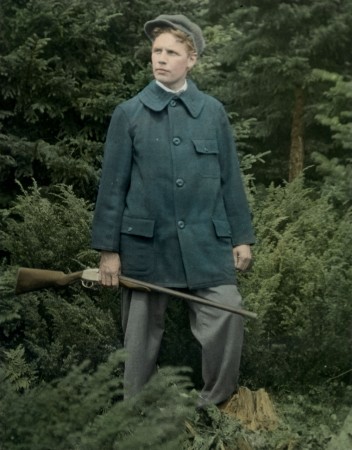L. L. Bean Stands By His Word | New England’s Gifts
In those days, the fabled L. L. Bean store in Freeport, Maine, was known principally for snowshoes and what we called “Barker Boots,” the rubber-bottom, leather-top, lace-up item that we thought was in universal use among lumberjacks in the deep woods of the North Country. If the bottoms ever wore out, we knew that L.L. Bean […]

At the flagship store, L. L. Bean himself demonstrates the features of his “Maine Hunting Shoe” to customer Don Williams in 1962. “Outside of your gun,” Bean stated in an early ad, “nothing is so important to your outfit as your footwear.”
Photo Credit : courtesy of L.L. Bean
Photo Credit : courtesy of L.L. Bean
In those days, the fabled L. L. Bean store in Freeport, Maine, was known principally for snowshoes and what we called “Barker Boots,” the rubber-bottom, leather-top, lace-up item that we thought was in universal use among lumberjacks in the deep woods of the North Country.
If the bottoms ever wore out, we knew that L.L. Bean would put new rubber bottoms on the old leather uppers for free. Everybody knew that; if they knew only one thing about L.L. Bean, they knew that he stood behind his guarantees forever. If they knew two things, they knew that his store was open 24 hours every day of the year except Christmas. This was, we assumed, for the convenience of lumberjacks on their way to the deep woods, and the occasional hunter or fisherman.
My father had a pair of Barker Boots (which the company called its “Maine Hunting Shoe”), and we knew he wore them when he went up to winter house parties in the White Mountains before we were born, times of unimaginable daring.
Later life would teach me that anything that comes from the hand of man can be had for a price, and I bought a pair of Bean hunting boots. They were made for the deep woods, not the harder surfaces of civilization, and before long a hole wore through the soft rubber bottom. I sent them back to Freeport, and they were returned. There was never a charge, but it was a nuisance.
One day I realized that there were three pairs of Bean boots in my closet, and each had been given two sets of new bottoms. This seemed paradoxical; the design was perfect, but it had a fatal flaw. So I called L.L. Bean and suggested that they make a new model of their venerable boot in which the chain-pattern gum bottom was replaced with something stouter. I suggested that Vibram might do the job. This bordered on heresy, but it made sense to me.

Photo Credit : courtesy of L.L. Bean
The call went to Freeport in the morning, and the new boots arrived in the late mail the next day, and there was no charge. I like to think it was L.L. Bean himself who made them, but it probably wasn’t. Obviously, though, a faithful lieutenant had gone straight from the telephone to the shop and made the new boots with the highest version of the leather top and a Vibram sole vulcanized on the rubber bottom. I wore them for two years; then I noticed tiny cracks in the rubber above the Vibram (I think it’s called the vamp). Apparently it was matched to the flex of the old gum sole, not the more rigid Vibram. I took the boots to Freeport and showed them to the Bean people, and they made a new pair for me with heavier rubber in the vamp, no charge. I’m still using them more than two decades later.
That’s the kind of thing that builds customer loyalty, and I bought whatever I could from L.L. Bean whenever I could. Then, incredibly, there was another shocking failure, two in the same lifetime. The blue cotton work shirt is another triumph of modern civilization; through most of my life they cost $3.50, and I always had several in current use. Then the price went through the roof. Crazed with loyalty, I bought three shirts at $15 apiece, even though they weren’t blue. The collars began to wear through before a year was out, but I kept the shirts anyway, more or less for old time’s sake, and wore them when I was working around home.
L.L. Bean eventually opened a store near my home in New Hampshire. One day I mentioned the unlooked-for decline in the lifespan of blue cotton work shirts, and the clerk said I should bring them in for a credit. I thought this was asking a little too much of L.L. Bean. After all, I’d used the shirts until they were in shreds.
Finally I did bring the shirts to the store, and the clerk looked at them and said that yes, they certainly had worn out. Then she gave me a $10 credit on each shirt, and I bought three more. So wherever you are in mercantile heaven, Mr. Bean, you should know that your legacy is in good hands.
—Nicholas Howe, adapted from a column in the Conway Daily Sun


